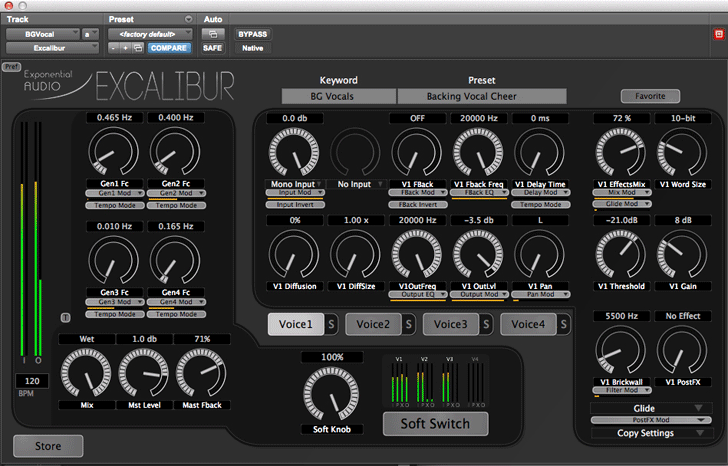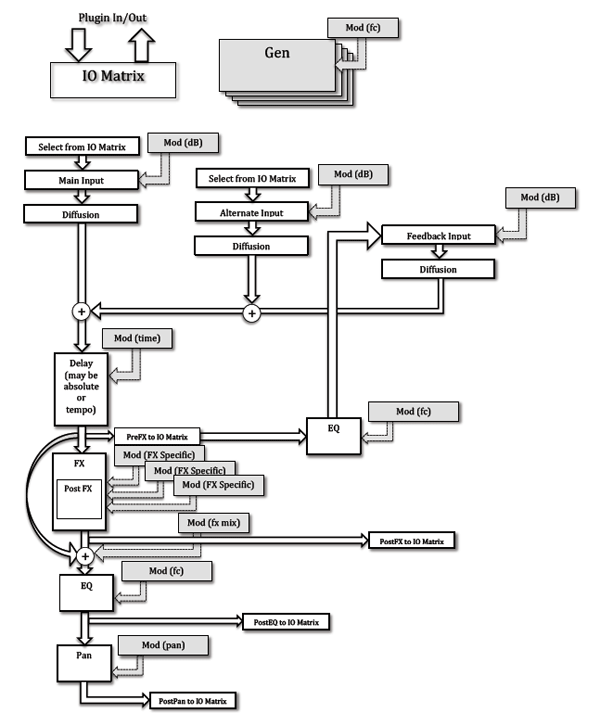 |
|
Exponential Audio Excalibur Multi-Effect Plug-in |
A nascent trend in modern music mixing uses time-based effects and signal processing as sound design tools to achieve unique, one-of-a-kind signature sound treatments within a mix. Exponential Audio's Excalibur offers a single integrated system to re-sculpt, re-shape and reimagine audio sources in a myriad of ways only limited by your imagination.
Excalibur is a multi-effect processor plug-in that runs in AU, VST, RTAS and AAX in 32/64-bit MAC or PC hosts and requires iLok 2 authorization. Excalibur is built using a four-voice framework with each voice having separate access to a big collection of delays, filter/EQs, distortion, resonant filters, reverb effects and more. Key to Excalibur's unique sound is its deep and labyrinth modulator system--automatic controllers routable to many points in the audio signal path using a virtual patch bay I/O matrix.
Control and More
In Excalibur's GUI center are the controls for the four voices with drop down menus for selecting a keyword and preset. Like Exponential Audio's R2 and Phoenix Reverb Plug-ins, Excalibur uses a keyword searchable library of presets. Select "Rotary" and all presets in that category will show up in the Preset box. You can modify and add presets, build a list of Favorites and store User presets within Excalibur for reuse in other audio programs in your DAW computer. As of this version 1.0.4 tested here, there are 550 presets with more added all the time.
Each of the four voices has a collection of parameter knobs for controlling EQ, gain, delay, feedback, panning, and the input source routing for each voice (two inputs possible per voice). Any voice can use any of 21 points in the signal chain as an input; the individual voice's PreFX, PostEQ, PreEQ points and the plug-in's L/R inputs & outputs are available.
A voice can use audio from another voice as input and there are free-running crackle and noise sources but no external input available as yet. Below the Voice section is the Voice Level meter; a global overview of all four voices with meters that read a voice's: Input, Prefx, PostfX, and Output levels--they are labeled I, P, X, O respectively. The meters indicate which voices are active in a preset and any clipping at those points in the signal chain easily controlled by the built-in limiters.
Auditioning sonic options is easy: just click one of the Voice buttons and then a parameter name. From there, a screen pops up for selecting modulation source, type, amount and other internal routing parameters. Soloing in Excalibur works differently than other multi-voice plug-ins. Because voices can be intricately interconnected, isolating a single voice in solo mode does mute other voices. Rather the solo'd voice(s), individual contributions to the preset's total sound is heard. However, I do wish there were individual voice mute buttons.
To the left of the Voice section are the Gen controls, four generators that are used to modulate the voice modules. The generators start as free-running LFOs with a collection of function generator waveforms, one-shot pulses, up/down ramps and more. Each generator also has switchable 1x, 2x, and 3x multipliers of their base frequency. You can also lock them or manually tap them to a tempo or any subdivision of it. The fun starts when these generators can be modulated using any patch point within the I/O matrix as well as any of the other four generators.
 |
|
Exponential Audio Excalibur Multi-Effect Flow Chart For One Voice |
You can also select the option to use the Soft Knob and/or the Soft Switch as modulators--a single knob and switch programmable for manual or automatable changes of many voice parameters at the same time.
Just below the Gen controls are the Mix/Master controls, Input/Output metering and tap tempo buttons. Excalibur conserves CPU load with the unique and clever processor level threshold feature. The default setting is -108dB; below which the plug-in sleeps but wakes up immediately when threshold is achieved. I found this transparent to Excalibur's operation and maybe one day this'll become a common feature in other plug-ins.
On the right side of the GUI are the voice effect controls. Separate effect treatments for each voice appear and disappear based on the preset chosen for each voice. Of course you can add effects to any (or all) of the four voice of an existing preset. Effects are: Chorus, Flanger, Phaser, Ring Modulator, four Resonator types, Distortion (nine different types), Resonant Filter, Glide (bit crunching distortion), Vintage Dual Pitch Shifter and a simple mono Reverb. The number of effects parameter knobs and names change depending on the effect--all have mixer controls subject to modulation.
Cutting With Excalibur
In Pro Tools 12 I was working on a mix for a young artist. I was looking for a unique vocal sound that would help to make her vocal's pitch-center somewhat ambiguous! I stepped through presets with Excalibur inserted as a mono-to-stereo instance on the lead vocal track. In general use, I found this the best way to find something to start with using a plug-in this deeply complex. Rather than try to divine and learn what was exactly going on in the preset, I would just solo individual voices and tweak until I got something I liked.
Excalibur takes a moment to instantiate in the mixer but it is super CPU efficient and exhibits just 32 samples of latency in Pro Tools (44.1kHz and 256 samples buffer size). Often I would have several instances in a mix with no glitches or buggy operation.
I found a preset called Gentle Flanger (Knob-Fc) that was interesting and began to tweak it. Presets that have the Soft Knobs or Soft Switches programmed are indicated in parenthesis--in this preset, the Knob controls the frequency center of the flanger.
I set up Voices 1 and 2 panned hard left and right as doubler/pitch shifters using the Vintage Shifter effect set slightly differently on both voices. Next I used Voice 3 panned mid-left and Voice 4 panned mid-right; both had timed delays with some feedback.
All of Excalibur's 445 parameters are automatable with any automated parameters remaining in place when changing or editing presets. So I automated the output level of voices 3 & 4--so when delay repeats showed up in where I didn't want them, I could fade them out. This effect sounded great--it had a way of sinking the vocal into the track yet still remain well heard.
For the backing vocals I tried my hand at a sound design effect. I started with a preset called Vintage Chorus (Knob-Dens)--it uses the Glide effect with an adjustable bit-depth/word size to simulate low rent digital audio streams. The Knob adjusts Density of the Glide effect of Voice 1.
I reset it to a very grainy 10-bit and followed it with the Brick wall roll-off filter set to 5.5kHz. Voices 2 and 3 were set to a watery chorus sounds panned left and right and lightly modulated by sine waves from Gen 1 and Gen 2 set to 0.46 and 0.40 Hz respectively. I automated the Knob to increase/decrease density--decreasing it makes the singers more intelligible (when they were unclear) and increasing the Knob smears in a good, analog way (when they were too clear).
For bass guitar I went through the presets in the Sound Design list and found a preset called Subtle Dirt. I began by dialing Voice 1's Distortion effect to sound like a loud bass amp using the Shred distortion position. Voice 2 applied a high pass filter effect the sound with Gen 1's sine wave set to slowly modulate a short delay to simulate slight detuning. Voices 3 and 4 were set to very subtle chorus and phaser effects. Considering I started with a clean direct bass recording, I thought Excalibur got it sounding very Rockin' and live
sounding.
Great Tool
Exponential Audio's Excalibur leans toward sound design in concept and functionality; it is a worthwhile tool to learn well. With so many presets included and more coming all the time from Exponential Audio's Michael Carnes, it spawns totally fresh approaches and ideas for effects when mixing modern Pop music. The vast soundscapes and treatments possible along with low CPU usage and flawless operation make it a super must-have processor. When I could not find just the right effect using many plug-ins in a chain, Excalibur came to the rescue every time with very unique, one-of-a-kind sounds unobtainable in any other way.
 |
Try This! |
 |
|
I had a very clean drum loop I wanted to rough up. Excalibur has both noise and two different crackle sound sources. I called up a preset called Fat Drums. It uses Glide distortion, a short mono room sound and noise and crackle. I stripped it down to just the crackles and noise sources and copied them to two voices for left and right panning. I cranked up the Glide distortion and then adjusted the EQs and amounts of crackles versus noise on each side, turned them way down and adjusted the over-all effect via the Mixer's controls. I had a modern drum loop tossed out into the dirty street using Excalibur.
--
Barry Rudolph |
|
 |
|
 | | |
|
 |
Exponential Audio |
 |
|
Web Site: www.exponentialaudio.com/excalibur-from-the-top/
Product: Exponential Audio Excalibur Multi-Effect Plug-in
Price: $199 Download
Pros: Completely malleable effects processor for any audio work!
Cons: Learning curve but well worth studying the 56-page manual. |
|
 |
|
 |
| |
Barry Rudolph is an L.A.-based recording engineer. Visit his Web site at:
WWW.BARRYRUDOLPH.COM
|
 Click Here To Return To The Directory Of Mix Magazine Reviews Click Here To Return To The Directory Of Mix Magazine Reviews
This Review Is Copyright ©
By Future Plc, an international media group and leading digital publisher. All Rights Reserved.
All Web Page Design Is Copyright © By Barry Rudolph
|
